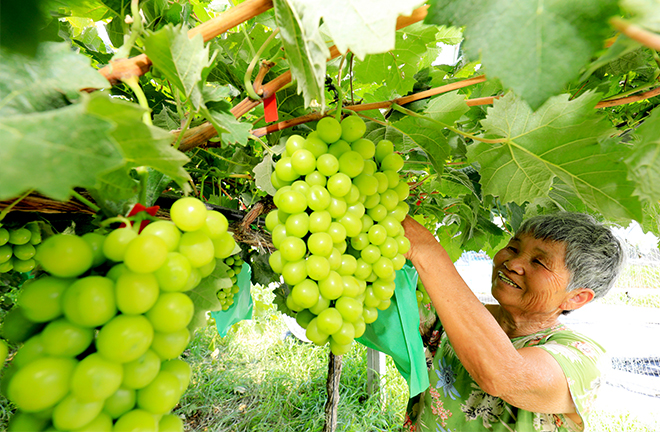Development-oriented social aid should focus on capacity relief

Development-oriented social aid is not just about monetary aid but about capacity relief. Photo: Li Xin/CNS
Development-oriented social aid introduces the dimensions of development to the idea of social aid. With a focus on capacity development, it provides a variety of relief services for poor families and aims to seek coordination between social policies and economic policies. Given the opportunity that China will formulate its Law of Social Aid, it is high time to establish a development-oriented social aid system, which is theoretically feasible and necessary in practice.
The first priority is to focus on capacity relief rather than just livelihood relief. Those who receive aid are also valuable human resources who can produce social wealth, and they also find it appealing and desirable to improve their own abilities and eliminate poverty. They should not simply rely on relief from the government to survive and subsist, but should be allowed to become active participants in the relief actions with self-reliant capacities.
Efforts should be made to enhance human capital and professional skills within the whole society, and the creativity of all people, including those in need of aid, should be valued. In the ideal social atmosphere, everyone is a participator. To be specific, we need to enhance the development potential of low-income groups, “teach them to fish rather than give them the fish,” and cultivate their abilities to earn normal remuneration from society and the market, to fundamentally eliminate poverty.
The second step is to focus on active prevention rather than post-event remedial actions. Development-oriented social aid focuses on eliminating or reducing various inducements that cause people to fall into poverty and emphasizes upstream interventions to cut off the chain of intergenerational poverty germination and growth. For example, we need to expand social investment and focus on mental health services so that impoverished groups can truly integrate into mainstream society. At the same time, a poverty early-warning system can be established. Instead of requiring those groups in difficulties to apply for assistance, it is better to take initiative and investigate and discover the problems. Support services that precede events can be provided to high-risk groups who are plagued by factors that cause poverty, or those who are on the verge of poverty.
Third, these measures should be government-led rather than government-arranged. In China, with the development of rural revitalization and urbanization, it is necessary for the government to play a leading role in administering social aid. However, leading is not “running the whole show.” It is necessary to actively guide non-governmental organizations to participate in social aid, as well as integrate enterprises, organizations, and individuals dedicated to public welfare and other social forces. The aim is to build a non-governmental social support network and transit the current small-scale welfare that is mainly complementary into the moderately universal welfare of the future, which covers everyone.
Fourth, with the background that absolute poverty has been completely eliminated, the goal of social aid should be changed from survival-oriented to development-oriented. On the one hand, bailouts are not necessarily limited to money and goods. The coverage of social aid should be expanded, from focusing solely on monetary goods to focusing on capacity, opportunity, service, and rights. At the same time, expenditures on vocational skill training, children’s education, public health, and public housing should be included into the scope of social aid. On the other hand, we should have left-over relief resources after the needs of basic survival are guaranteed and other needs such as trainings for employment or start-ups should be further satisfied. In addition, although some families’ income levels exceed the poverty line, their actual living standards are still in a state of absolute poverty due to fixed expenditures necessary for living a life. These are practical problems facing social aid which need to be solved in a targeted and precise way.
Fifth, development-oriented social aid emphasizes different relief methods based on different targeted groups. For example, attention should be paid to health services and educational assistance for juveniles. For the disabled and the elderly—who have lost the ability to work—it is important to improve their incomes, provide elderly care, and medical services. For those who have the ability to work but with insufficient income, it is necessary to insist on “teaching them how to fish,” to reduce the share of relief that they receive, and to clearly stipulate some behavioral requirements.
Sixth, we must optimize and integrate the operating mechanism to ensure that advanced concepts and reasonable system designs can be implemented. Traditional social aid in China has been run by different public institutions, involving departments such as education, civil affairs, housing and urban-rural construction, human resources and social security, emergency management, and medical security. As a result, the policy was formulated by multiple departments and a policy block division exists, along with dispersed relief resources and insufficient cooperative momentum. Therefore, promoting the establishment of an integrated inter-departmental aid mechanism is the focus of the future reform. In 2020, the General Office of the CPC Central Committee and the General Office of the State Council jointly issued the Opinions on Reforming and Improving the Social Aid System, which transformed the scattered individual aid system into a comprehensive aid system. However, further optimization is still needed to truly solve the problem of multi-department management.
Yu Shaoxiang is a research fellow from the National Institute of Social Development at the Chinese Academy of Social Sciences.
Edited by BAI LE

 PRINT
PRINT CLOSE
CLOSE